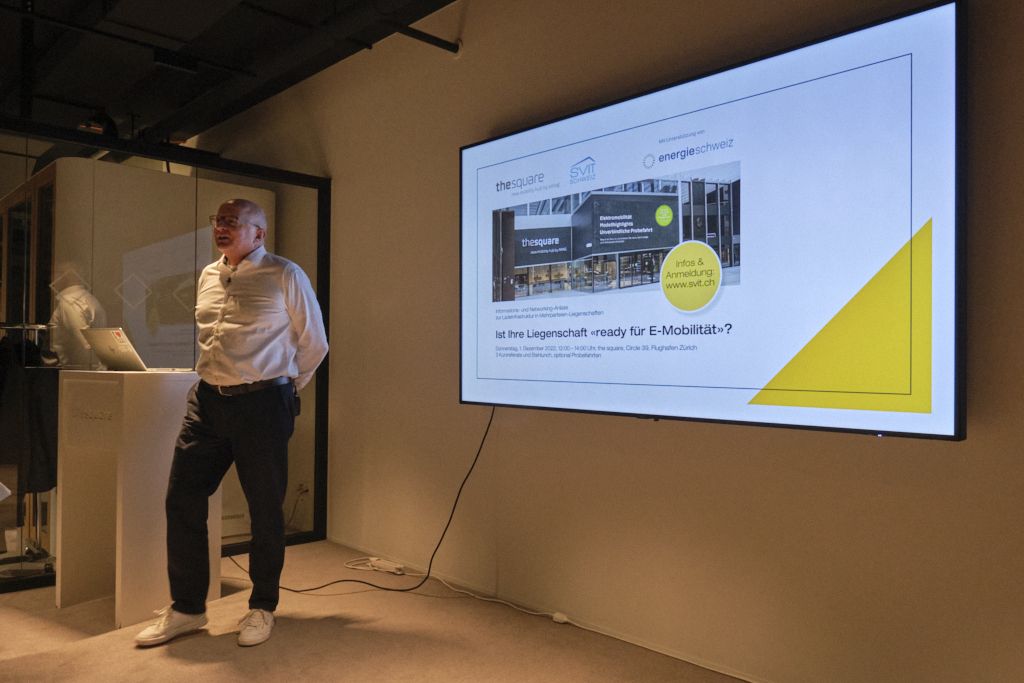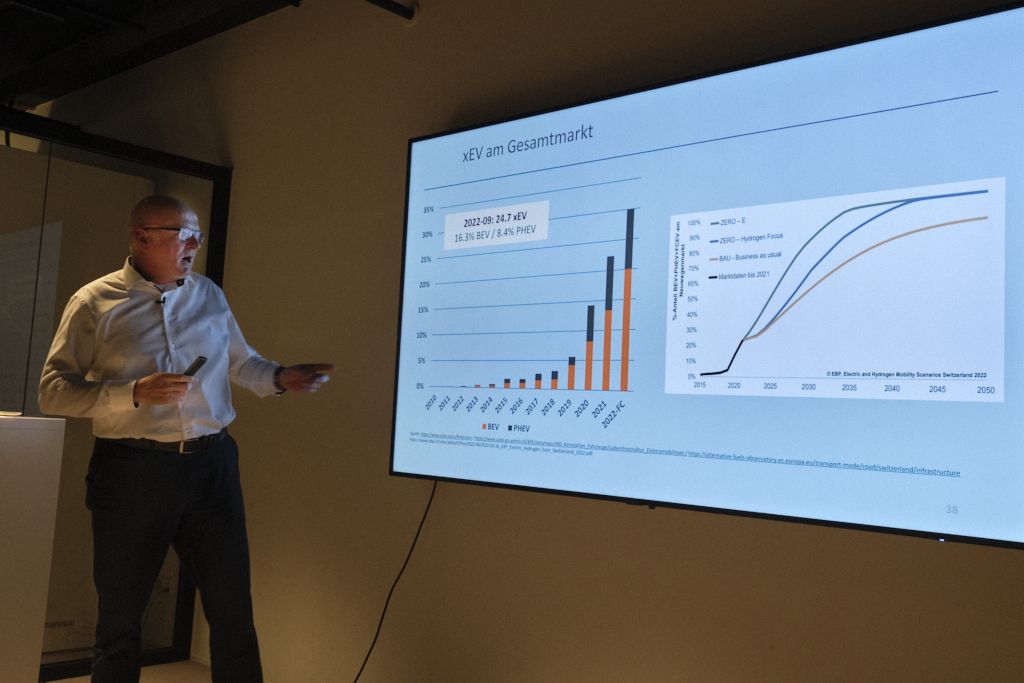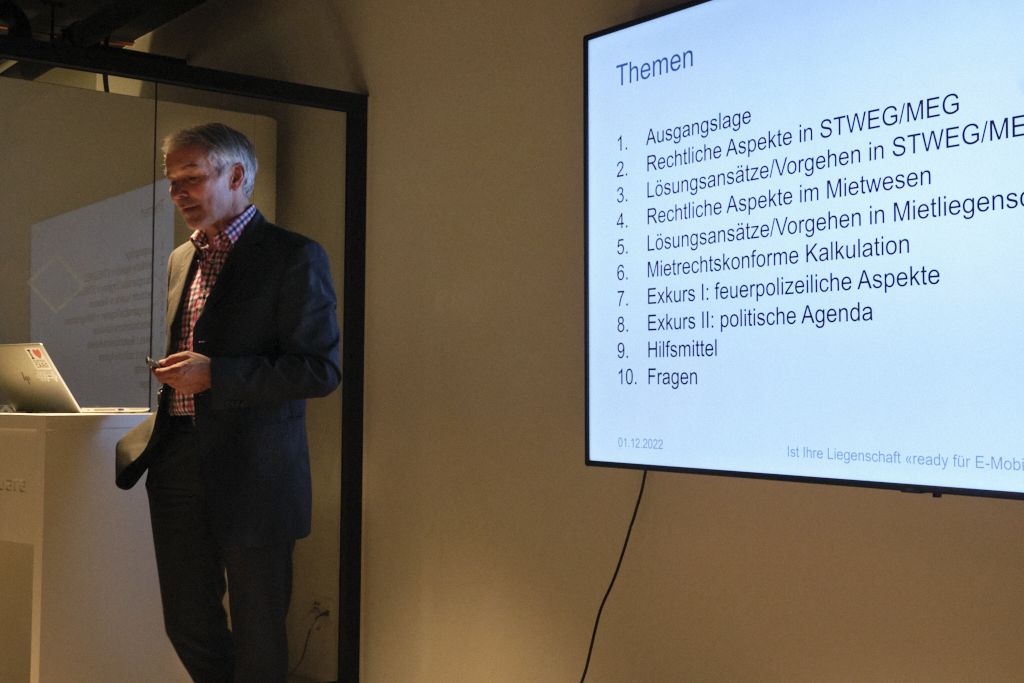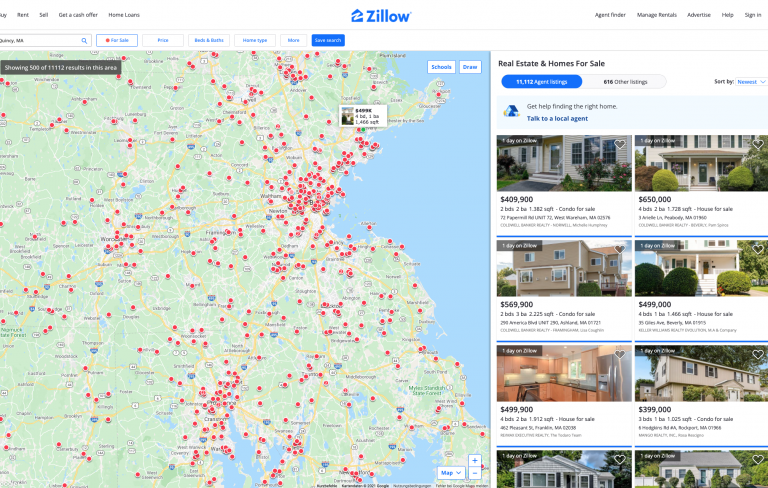As part of an information and networking event, representatives of SVIT and AMAG talked about the rapid development of e-mobility and the need to quickly equip multi-party properties in particular with suitable charging options in the ultra-modern “square – new mobility hub” at The Circle. In doing so, they not only proved how serious the car industry is about electrification, but also showed the opportunities and stumbling blocks in the new or retrofitting of these properties with charging stations.
The event took place on 1 December 2022. For all those who would have liked to have been there themselves, it will be repeated on 9 February 2023 and 6 April 2023, again from 12.00 to approx. 14.00 with a standing lunch at The Square at Zurich Airport. Following the events, test drives with almost all electric cars from the AMAG range are also possible on request.
A rapidly growing number of tenants and condominium owners would like to have a charging infrastructure for electric vehicles at their residence, according to the invitation to the event. For owners and landlords as well as administrators of condominium associations, numerous questions arise in this context: Which variants of expansion are possible? Should I finance/operate it myself or look for a contracting partner? How do I bill in accordance with tenancy law?
Dismantle myths and develop solutions

Peter Schmid, Head of new mobility hub by AMAG informs about the future of e-mobility. Photo: © Werner Mäder
Peter Schmid, Head of new mobility hub by AMAG, showed in his short presentation that most of the reasons currently put forward against e-mobility belong to the realm of myths. Those who believe that there is not enough electricity for e-vehicles are overlooking the fact that energy consumption in Switzerland has fallen by 12 percent and electricity consumption by 4 percent in the last ten years. It also neglects the fact that private transport with combustion engines is dependent on the Middle East for about 80 per cent of its energy.
Ecologically, too, e-cars are more advantageous than combustion engines: with the European electricity mix after about 57,000 kilometres, with the Swiss electricity mix with its high share of renewable energy much earlier – and with pure solar electricity from own production already after about 25,000 kilometres driven. In this way, one not only emits less CO2, but also drives much more cheaply, despite somewhat higher purchase costs.
The range of electric cars is more than sufficient at a realistic 300 – 550 kilometres per charging cycle: with today’s fast-charging options, this means that you have to take a half-hour break after a three-hour drive. It should also be borne in mind that the average daily distance travelled in private transport is around 40 kilometres, says Schmid. The battery problem has also been solved for a long time: a car battery lasts for 10 to 15 years. Then it is still powerful enough for a “second life” in the stationary area at home. After that, 96 per cent of it can be recycled with today’s technology.
For these reasons, Schmid is convinced that e-mobility will quickly become established. This is also shown by the plans of practically all car manufacturers to completely abandon the sale of combustion engines in just a few years, as well as the targets set by the EU. According to Schmid, around 80 to 100 percent of new vehicles sold should be fully electric as early as 2035. Therefore – according to Schmid – charging stations are needed in the underground garages of multi-party properties. The question is not if, but when. Schmid: “It will soon be difficult to rent flats without charging stations.
How do you make a property ready for e-charging?

Representing Alexander Beck, Charging & Energy Solutions Manager Volton, AMAG Import AG, Peter Schmid talks about the prerequisites for the successful installation of charging stations in properties; Photo: © Werner Mäder
The company Volton, a subsidiary of AMAG, is dedicated entirely to the topic of charging infrastructure. It offers complete solutions for e-mobility – in companies and in larger garages of rental and owner-occupied flats. Representing Alexander Beck, Charging & Energy Solutions Manager Volton, AMAG Import AG, who was unfortunately unable to give his short presentation in person, Peter Schmid also took over the part on “E-Mobility@Properties: Load Management”.
Volton expects that the EU’s planned emission regulations will make internal combustion engines massively more expensive. In Switzerland, e-mobility is being promoted through the Roadmap Electromobility 2025. And surveys show that the most important charging location for e-cars in Switzerland is likely to be at home. Therefore, the demand for charging options for tenants and owners is likely to increase rapidly soon.
However, there are a few challenges when installing a charging infrastructure in an existing building:
- The available cable capacity must be used optimally.
- Scaling the installation must be easy and cost-efficient.
- The charging solution must meet the highest safety requirements.
- Charging energy must be properly accounted for and billed.
- The technology must be durable and future-proof.
- The charging stations should be theft-proof.
All the details can be found in the SIA 2060 information sheet “Infrastructure for electric vehicles in buildings”, which you can download here as a PSD (CHF 160). There you will also find the official online calculator, which enables quick and easy project planning.
The legal and business perspectives from SVIT’s point of view

Ivo Cathomen, Deputy CEO SVIT Switzerland, informs about the legal and economic perspectives of installing charging stations in multi-party properties; Photo: © Werner Mäder
Ivo Cathomen, Deputy CEO of SVIT Switzerland, spoke about the legal and economic perspectives. He also assumes that among the possible scenarios for frequent charging in Switzerland, the one at home is likely to prevail. This means that in our country, the infrastructure for e-car charging must be created in the properties: at home or at the workplace. By 2050, it is expected that around 3 million home charging stations will be needed in Switzerland. In the short term, installation is a priority, especially in more upscale properties.
In condominium ownership or co-ownership (STWEG/MEG), no special rights are normally granted. Therefore, there is also no unconditional right to install a charging station by individual owners. In any case, a decision of the community is required. If they agree, the costs of individual solutions are always borne by the applicant. However, Cathomen describes the installation of individual solutions as a dead end. He therefore recommends the installation of a suitable basic infrastructure by the STWEG/MEG at their expense. The connection can then be made individually and gradually by the owners.
In the case of rented properties, the installation of a charging infrastructure is considered 100 per cent value-enhancing, but it requires a contract amendment. Cathomen recommends the following procedure for rental properties:
- Check available capacity
- Decide between Ready to Charge (incl. wallbox) or Power to Parking.
Here, too, individual space solutions by tenants should not be permitted under any circumstances. Such solutions are only conceivable for commercial tenants with long-term contracts.
For those who would like to learn more about the correct procedure, Cathomen recommends the SVIT leaflet, which you can download as a PDF here, and the HEV leaflet, which you can download as a PDF here (CHF 7.50 for HEV members, CHF 9.50 for non-members).
SVIT Switzerland and AMAG are partners in the “Roadmap Electromobility 2025” of the Swiss Federal Office of Energy and thus involved in the development of recommendations and standards at the forefront.


